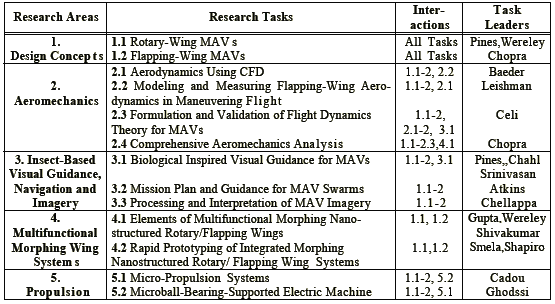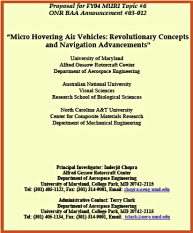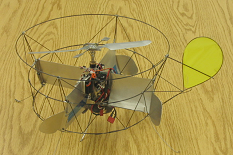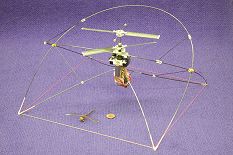![]() Phase 5: MURI: Micro Hovering Air Vehicles:
Phase 5: MURI: Micro Hovering Air Vehicles:
Revolutionary Concepts and Navigational Advancements
- Sean Humbert (micro systems, 2006)
- Army-MURI: 5-year program in Micro Air Vehicles, (2004-09)
Team Members: Australian National University, North Carolina A&T
“Micro Hovering Air Vehicles: Revolutionary Concepts and Navigational Advancements” - DARPA Quieting Program: 3-year (05-08), Team Partner: Stanford
“Advanced CFD methodology to predict vibratory loads and acoustic signatures”
Objective: Develop next generation micro hovering air vehicles (rotors and flapping-wings) with biologically inspired navigational systems
Max dim.= 15 cm, Weight=100 gm, Payload= 20 g Endurance=60 min
Team: UM, Australian National University, North Carolina A&T
5 year program (2004-2009)

 |
 |
Coaxial Rotor |
Single Rotor with Anti-Torque Vanes |
|
|
Potential Pay-off to Rotorcraft Center
- Additional resources to train rotary-wing graduate students
- Help to expand and upgrade the existing rotorcraft infrastructure
(experimental facilities, CFD and aeromechanics methodologies) - Expand the frontiers of sensors technologies
- A major push in autonomy (soft ware and hard-ware)
- Develop new methods of fabrication (Rapid prototyping and micro parts)
- Innovate out-of-box solutions (Cyclocopter, active vanes and flflapping-wings)
- Improve knowledge-base in low Reynolds number aerodynamics and ultra-light materials
About AGRC | AGRC History | Gessow | Contact Info | Chronological Events


